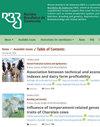Multivariate analysis of sources of polyunsaturated fatty acids, selenium, and chromium on the productive performance of second-cycle laying hens
IF 1.2
4区 农林科学
Q3 Agricultural and Biological Sciences
Revista Brasileira De Zootecnia-Brazilian Journal of Animal Science
Pub Date : 2022-01-01
DOI:10.37496/rbz5120210204
引用次数: 1
Abstract
An experiment was conducted to evaluate the effect of the intake of a mixture of fish and sacha inchi oils (iOM), organic selenium (iSe), and organic chromium (iCr) on egg pro duction (EP) and feed conversion ratio (FCR) of Isa Brown second-cycle laying hens (SCLH) for 16 weeks (91-106 weeks old). Egg production and FCR were evaluated using multivariate models that included conventional equations and artificial neural networks (ANN) to study multiple nutritional interactions as alternatives to univariate dose-response models. Based on the best models, iOM, iSe, and iCr levels were optimized, and a global sensitivity analysis was implemented to quantify their influence on EP and FCR. The modified logistic model was selected as the best strategy to represent EP. In the case of FCR, an ANN model with a feed-forward architecture and softmax transfer function was selected as the best alternative. One of the scenarios to simultaneously optimize EP (89.1%) and FCR (1.94 kg feed/kg egg) at 16 weeks of production was established with 3.3 g/hen·day of iOM, 0.132 mg/ hen·day of iSe, and 0.176 mg/hen·day of iCr. However, optimization considering only FCR results in much lower optimal iCr levels (between 0.083 and 0.105 mg/hen·day) with a slight decrease in EP (87.9%). The global sensitivity analysis showed that iSe is an essential factor associated with the increase in EP, and iCr is the most influential factor for the decrease in FCR. When both criteria were taken into account simultaneously from a desirability function, iSe was the most critical factor.多不饱和脂肪酸、硒和铬来源对二循环蛋鸡生产性能的多变量分析
本试验旨在研究鱼麻油(iOM)、有机硒(iSe)和有机铬(iCr)对伊沙布朗二循环蛋鸡(SCLH) 16周龄(91 ~ 106周龄)产蛋量(EP)和饲料系数(FCR)的影响。采用多变量模型评估产蛋量和FCR,该模型包括传统方程和人工神经网络(ANN),以研究多种营养相互作用,作为单变量剂量-反应模型的替代方案。基于最佳模型,优化iOM、iSe和iCr水平,并实施全局敏感性分析以量化它们对EP和FCR的影响。选择改进的logistic模型作为最佳策略来表示EP。在FCR的情况下,选择具有前馈结构和softmax传递函数的ANN模型作为最佳选择。以3.3 g/母鸡·d的iOM、0.132 mg/母鸡·d的iSe和0.176 mg/母鸡·d的iCr为条件,建立了生产16周时同时优化EP(89.1%)和FCR (1.94 kg料/kg蛋)的试验方案。然而,仅考虑FCR的优化导致最佳iCr水平低得多(在0.083 ~ 0.105 mg/母鸡·d之间),EP略有下降(87.9%)。全局敏感性分析显示,iSe是EP升高的重要因素,iCr是FCR降低的最重要因素。当从可取性函数同时考虑这两个标准时,iSe是最关键的因素。
本文章由计算机程序翻译,如有差异,请以英文原文为准。
求助全文
约1分钟内获得全文
求助全文
来源期刊
CiteScore
1.90
自引率
0.00%
发文量
25
审稿时长
8 weeks
期刊介绍:
The Revista Brasileira de Zootecnia (RBZ; Brazilian Journal of Animal Science) encompasses all fields of Animal Science Research. The RBZ publishes original scientific articles in the areas of Aquaculture, Biometeorology and Animal Welfare, Forage Crops and Grasslands, Animal and Forage Plants Breeding and Genetics, Animal Reproduction, Ruminant and Non-Ruminant Nutrition, and Animal Production Systems and Agribusiness.

 求助内容:
求助内容: 应助结果提醒方式:
应助结果提醒方式:


